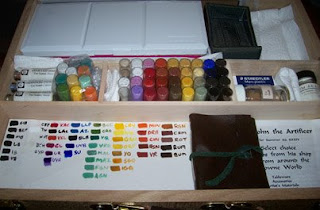Yesterday I had the pleasure of attending Nova Schola hosted by the Shire of Hartshorn-dale in the East Kingdom. The day was full of interesting classes, many knowledgeable folks and a delicious dayboard. I didn't bring my camera to the event, so alas no pictures. I will share a little about the classes I attended and some interesting information and resources I aquired throughout the day.
-----------------------------------------------
Arrow Making- taught by Naomi bat Avraham
-----------------------------------------------
I wanted to attend this class to have the chance to try some techniques in person and was very pleased with how well stocked and prepared the teacher was to show just that.
Some things I learned:
- Ash, while a strong wood for shafting, does not want to stay straight.
- You can use higher spine weights than your bow, but never lower ones.
- Giant feather fletching is used to create Floo Floo arrows for bird hunting.
- Right wing arrows are from the right wing of a bird and have their catch to the left.
- You can attach points with a glue gun. Fancy that.
- Fletching jigs are less complex to use than they look.
Some resources from class:
Naomi's Website w/ Arrow Making TutorialHigh Quality Cedar Shafts----------------------------------------
Simple Period Tunics taught by Bertana
----------------------------------------
I actually walked into this class thinking it was period handsewing, but realized that I mixed up the times and decided to stay since I knew the teacher and might learn a few things. A good selection of handouts were available in this class.
Some things I learned:
- Underarm gussets can be cut directly from the sleeve.
- Handstiching is the easiest way to sew a neckline. (I've always struggled with this on a machine.)
- Your basic tunic made from a geometric pattern is seen across many cultures and many centuries, making it a very versatile starter piece.
- Couching embroidery and simple chainstitch outlines can be used for embellishment.
Resources from class:
Pictures of extant tunics (includes Bocksten and Skjoldehamm)
----------------------------------------------------------
Authenticity 101 taught by Mistress Brangwayna Morgan
----------------------------------------------------------
I was hoping this class would maybe cover some methods for researching accurate sources for projects and give some tips on common pitfalls. Mostly we covered that those who are interested in authenticity are not "Period Nazis" or "The Authenticity Police" and that authenticity can be fun. I did pick up on some interesting bits of information in this class.
Some things I learned:
- Most people who provide unsolicitied criticism of attempts at garb are not experts in the area.
- Wool socks will keep your feet dry at war.
- Your recreations are only as accurate as your source.
- Vikings had access to silk in the 700s and 800s, but not again for several centuries.
- The easiest was to move towards seeming more authentic is to relate your modern experiences to period terms at events. Such as "I recieved a message." rather than "I got an e-mail."
-----------------------------------------------
Intro to Scribing - taught by Violante de Rojas
-----------------------------------------------
I was hoping that we would get the chance to talk about some period pigments and tools in this class, but as it was an intro we didn't delve as much into that. This class was an excellent overview of supplies and resources.
Some things I learned:
- You can use
Sheaffer's calligraphy pens for scrolls.
- You can get refill cartriges for said pens to fill with
waterproof ink.
- You can use
Gouache for painting illuminations. Fancy that!
- Bristol paper is NOT good for scrolls.
-
Hot press watercolor paper and
Pergamenta are excellent paper choices.
- Use an
X-Acto with a rounded blade for scraping, never a pointed blade.
- Don't let cats near scrolls!
- Don't use brushes intended for oil painting for illumination.
-
Loew-Cornell's watercolor brushes are a better option. Personally, I've always be fond of their American Painter brushes.
- Use a
white eraser and a large paintbrush to brush away eraser bits.
- NEVER blow away eraser bits from scrolls.
-
Higgins Eternal is an excellent scroll ink for calligraphy.
- Borders on a scroll should be 1" to 1.5".
- The
Ames Lettering Guide along with a cork backed
C-Thru Metal Ruler are your friends.
- Quill dip pens WILL splatter.
- Manuscript pens are not very good, neither are Speedball.
- As a beginning scribe you will likely be paired with a mentor.
Resources from class:
A History of Illuminated Manuscripts by Christopher De Hamel
Medieval Calligraphy by Marc Drogin
----
Aside from classes yesterday I finally had the chance to submit my device for a conflict check and worked on documenting my SCAdian name. It's a big step that's been put on the back burner far too long. I am excited about the process and have been recieving a lot of help from the incoming Eastern Crown Herald, Lillia de Vaux. I'm sure I will add a post as that all progresses.
 "Hey, I found another budgie in this shiny part of my gym! "
"Hey, I found another budgie in this shiny part of my gym! "
















